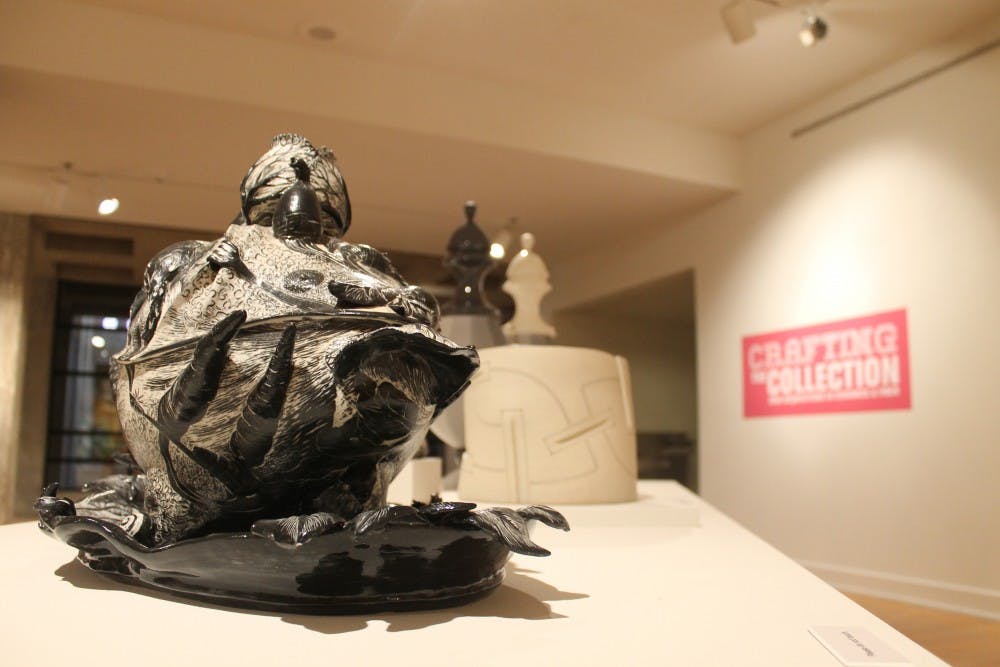The Nelson Fine Arts Facility at the ASU Art Museum re-opened its doors July 5 after a month-long refurbishment period in June. The opening included two of the four new installations planned for the late summer of 2016.
Heather Lineberry, Senior Curator and Associate Director at the ASU Art Museum, said the museum’s summer exhibitions focus on pulling from the museum’s own Permanent Collection and presenting these pieces in new and exciting ways.
“It is an opportunity to see some spectacular new objects from our collection,” Lineberry said.
Most exhibitions are on display for about three or four months, Lineberry said, and the museum usually follows the seasons of the academic calendar.
“Each time students come back to campus from having been on a break, we will, in all likelihood, be mounting a new series of exhibitions,” she said.
Crafting the Collection
“Crafting the Collection” opened July 5 and will be available to view until September 3.
Featured in the museum’s Turk Gallery, the installation showcases more than 30 new pieces donated to the museum among other ceramic and craft works of art.
The ASU Art Museum holds about 4500 ceramic pieces in its Permanent Collection, according to Museum Ambassador Juan Paez.
Although there exists a wide spectrum of ceramics and crafts, this art form is often stigmatized in the art community and beyond, according to Paez. Some view the creation of crafts and ceramics as craftsmanship rather than an art, he said.
Because these works are not always categorized as fine art, Paez said, the museum decided to showcase their beauty through this collection.
The museum’s opening in the 1950s marked a shift in many schools of thought; however, and ceramic artists such as Peter Voulkos and John Mason helped establish ceramics as a craft worthy of inclusion in museums, according to the collection’s description in the museum.
The installation is home to many ceramic pieces, but also features Japanese artist Ai Kijima’s "Night is Young," a fused, machine quilt of fabrics featuring multi-generational pop culture icons, such as Snow White.
The Brandywine Workshop Collection
The “Brandywine Workshop Collection” will be available from July 5 to December 17.
Hosted in the museum’s multi-purpose room, this collection features prints from the Brandywine Workshop, a nonprofit organization based in Philadelphia that focuses on culturally diverse and multi-ethnic printed art.
Retired Curator Jean Makin traveled to Pennsylvania to hand-select the 59 pieces of artwork for this exhibition.
18 of the 59 selected prints are displayed in the collection, and are “culturally diverse, social, political, spiritual and abstract with vibrant colors, energy and narrative,” according to the museum’s website.
The museum will open two additional installations, “The New Animist,” and “Encounter,” in its Kresge and Americas galleries later this month.
The New Animist
"The New Animist," curated by Windgate Curatorial Interns Kev Nemelka and Angelica Fox, will be available in the museum from July 16 to September 3.
“The purpose of the show is to sort of delineate between Old Animism and New Animism,” Nemelka said.
Nemelka said the idea of Old Animism dictates that all objects, including inanimate objects, have some sort of spiritual life force or energy. This is often associated with primitive or childlike thinking, he said.
“With New Animism, it’s kind of like a re-conceptualization of Old Animism, [...] putting it into a context of contemporary eco-consciousness.”
“There’s this idea that we should avoid spiritual domination,” Nemelka said, explaining that over-fishing or over-mining would be considered disrespectful in the New Animist philosophy.
New Animists believe that the ability to exist and the ability to have an identity are not exclusive to humans, Nemelka said.
“We as human beings have a very human-centric idea of what being alive means, but with New Animism, personhood is attributed to other-than-human persons,” Nemelka said.
“My selection of these works, is, in a lot of ways, a re-contextualization of some of the artwork. Some of them perhaps don’t have much to do with eco-consciousness or seem to be part of a conversation about animism,” Nemelka said.
However, either the material, content or form of the works allow Nemelka to re-envision possibilities for the artwork, he said bringing together seemingly unlikely pieces to tell the story of New Animism .
These connections between the works of art and New Animism are clarified by the educational curation done by Angelica Fox, who has integrated technology into the museum via this exhibition.
Encounter: Better to have loved and lost than never to have loved at all
Interdisciplinary artist Alejandro Almanza Pereda was selected to create the installation and exhibition “Encounter: Better to have loved and lost than never to have loved at all,” which will be open from July 30 to November 26.
“It’s part of our series where we invite contemporary artists to select objects from our collection to re-imagine and re-contextualize those objects, to help us rethink our collection, our archive and its relevance for our students and our audiences,” Lineberry said.
“Better to have loved and lost than never to have loved at all,” is the third in the Encounter series, where artists are invited to come to the museum and re-invent pieces of the its Permanent Collection in conjunction with their own work, according to a museum pamphlet.
“So they come in and they look at our collection and they make surprising and interesting and fascinating selections. Perhaps selections that we would not have made,” Lineberry said.
Pereda’s exhibition focuses on still life, and displays several still life paintings from the museum’s Permanent Collection, upside down.
He also created still life videos, which he filmed inside a Phoenix swimming pool.
The museum will open several new exhibitions on September 23.
Reach the reporter at ekamezak@asu.edu or follow her on Twitter @emikamezaki
Like The State Press on Facebook and follow @statepress on Twitter.




